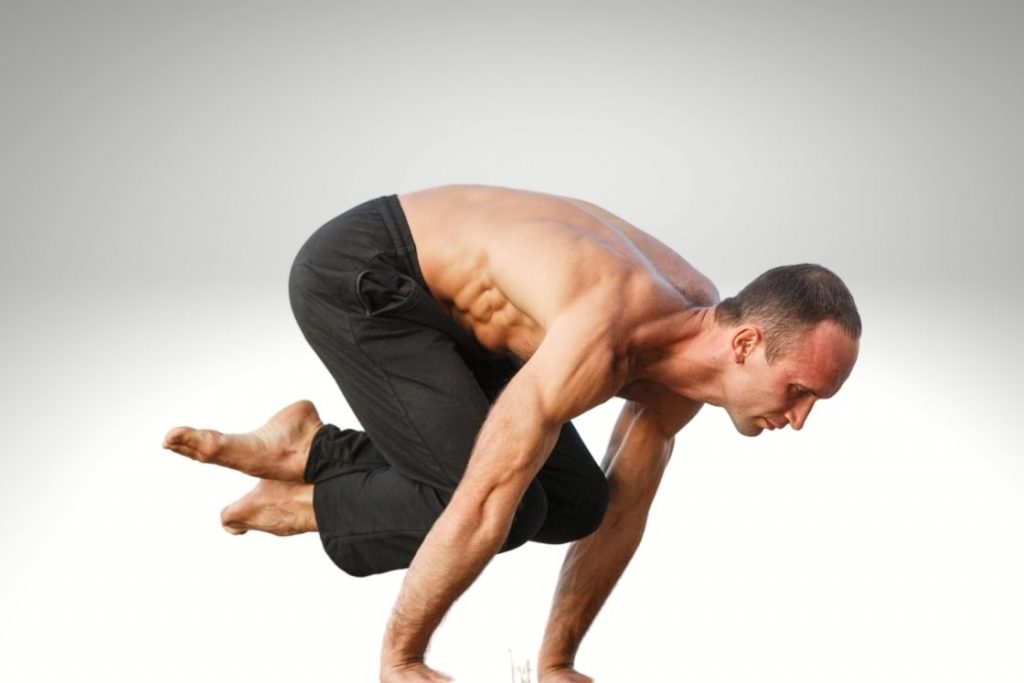
Lolasana is an arm balancing asana in modern yoga. It strengthens wrist, forearms, shoulders, and tons up core muscles, upper back.
This simple looking posture requires immense strength in hand along with a sharp focus to remain in the posture. In appearance, lolasana looks similar to crane pose but it’s different in practice.
To achieve the final lolasana pose, you have to practice its preparatory poses consistently. Back to the back practice of this asana can transform a practitioner’s body into a muscular and strong structure.
Meaning
Lolasana is a Sanskrit word which can be easily comprehended as ‘Lol‘ means ‘fickle’ or ‘dangling’ and ‘asana’ means ‘pose’.
In lolasana, a practitioner’s body remains hanging in the air on being supported by the hand. Due to this, it is also known as Jhula (means swing in Hindi). This asana also signifies a hanging pendant and so it’s called Pendant Pose.
In 1896, Lolasana first appeared in a gymnastic manual named Vyayama Dipika as a balancing movement exercise called Jhula.
Norman Sjoman, the author of the yoga tradition of Mysore palace, suggests lolasana is one of the poses adopted into the Modern Yoga by Krishnamacharya (father of modern yoga).
Further, this pose had been taken up by his students Pattabhi Jois and B.k.S. Iyenger.
Practice Guide of Lolasana
These steps can be taken for the safe and healthy practice.
Precautions & Contraindications
- Practitioners with the condition of the wrist like dislocation, sprain, DeQuervain’s Syndrome (inflammation of tendons) should refrain from doing Lolasana.
- People with the condition of cervical vertebrae, neck sprain, shoulder injury also avoid this asana practice until become fine. otherwise, it could worsen the current state.
- Pregnant and menstruating women should not indulge themselves in this asana practice. As it might lay stress on the abdomen.
Preparatory Pose
Lolasana Steps
- Begin by kneeling over the floor. Your torso and head should be perpendicular to the floor. Just like in Vajrasana.
- Inhale to align your body. Now, rest your hands on either side of the knees wide apart. Let there be a space between your shoulder blades as come into the posture.
- From here, Inhale deeply and gather up your core strength to thrust it toward the upper back. Now, exhale and raise your upper torso in an upward direction.
- Stabilize your hand on the floor. After combining the strength of core, wrist, upper back along with a firm finger’s grip, lift off your body from the floor.
- Your ankles remain crossed and push your lower ankle up. Contract your abdomen to supply the constant strength.
- Hold the posture here.
Release
Remain in the posture for 30 to 60 seconds. However, practitioners with developed core, wrist and shoulder strength can optimize their time period.
After the accomplishment of given time lower your body by releasing the core and let it touch the floor. Uncrossed ankles and then leg. Shake your hands and roll your wrist slowly.
Beginners Point
- Beginners should take time to reach fully into the posture. Avoid overstraining initially let your body find the way to the victory.
- In case of lifting off the body, one can try to lift as per their strength or while keeping feet on the floor. This will reduce stress on the wrist and could save you from injury.
Props and Modifications
- Initially, it would be difficult to suck up your lower body due to low core strength. To overcome this use blocks in lolasana. Place blocks on either side of the knees. It will ensure the sufficient height for leaning forward and uplifting.
- Wambling of the wrist can be reduced by developing strength in them. After investing some time in chaturanga dandasana practitioners can develop some feat to tackle this shakiness.
Follow Up Pose
- Crane Pose (Bakasana)
- Four-Limbed Staff pose (Chaturanga Dandasana)
- Crow Pose (Kakasana)
Variation
By opting some changes one can practice the variation of lolasana.
Padma Lolasana
In this variation, legs are crossed in Padmasana and then body raised off the floor.
From the kneeling position of Lolasana, Practitioners can place their right foot on the left thigh and left foot on the right thigh. This will give you Padmasana. Now by taking the hand support lift off the body in the air and maintain the posture.
Lolasana Benefits
- Lifting off the body in Lolasana lays an intense pressure over the wrist, shoulder, and upper back. This makes them strong by increasing bone density.
- This asana involves core strength that assists in body lifting. In doing so, it harnesses the abdominal muscle strength. However, regular practice of this asana eradicates abdominal disorder and respiratory disorder like bronchitis, etc.
- According to one study the regular practice of Lolasana along with other yoga practices can improve subjective well-being, daily basic living skills, personal hygiene, self-care, social-interpersonal activities and communication, and self-discipline in Schizophrenia patient.
- This asana requires core strength which can be only acquired by regular practice of this asana. In doing so the practitioners with belly burn lots of calories. Therefore, loses belly fat.
- The abdominal contraction in lolasana contributes to improving the digestion process. It rejuvenates the digestive organs which result in the optimum secretion of digestive juices and enzymes. Hence, aids in digestion.
- Maintaining posture for some period of time requires willpower along with concentration. By practicing this asana practitioners can get control over themselves and can improve their concentration as well.




